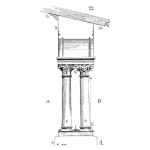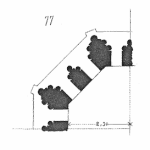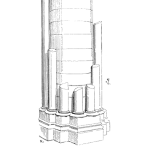
There are two main ingredients for a successful reliability centered maintenance (RCM) analysis:
- First-hand knowledge of the asset and its operating environment.
- Strong understanding of the RCM process and its associated principles.
Your Reliability Engineering Professional Development Site
A listing in reverse chronological order of these article series:
by Nancy Regan Leave a Comment

There are two main ingredients for a successful reliability centered maintenance (RCM) analysis:
by Karl Burnett Leave a Comment

By 1792, six Royal Navy dockyards employed about 1500 workers each. The dockyards had a wider variety of technical specialties than was found in any other manufacturing enterprise. The dockyards “were some of the largest manufactories in Europe and dwarfed almost all private industries.” (Morriss) The dockyards built new ships, but maintaining ships was just as important. The Royal Navy’s dockyards constituted one of the largest industrial maintenance organizations in the world…and their only peer organizations in terms of the scale of maintenance management were the dockyards of other superpower navies.
[Read more…]by Mike Sondalini Leave a Comment

The duties of the engineering manager role usually include capital project management and maintenance management, two vital aspects that must be done exceedingly well in an industrial operation.
by Mike Sondalini Leave a Comment

A presentation slide set titled “Simpler Industrial and Business Process Redesign”. Presented by Mike Sondalini to The Institution of Engineers, Malaysia, Electrical Engineering Technical Division.
The presentation opens with examining three universal business problems:
He also explores the implication of the quality loss function and then incorporates the concept of maintenance work quality. Then Mike explore specific steps you can implement to improve the fundamental processes within your organization.
[Read more…]by Nancy Regan Leave a Comment

Let’s dispel five common myths about reliability centered maintenance, including:
by George Williams Leave a Comment

Think back to the restaurant mess we talked about a few pages back, who was responsible?
The lesson for grown-ups (and more importantly executives and business leaders) from The Boy Who Cried Wolf is that the boy was at fault when he lied the first time, but the person who was really responsible for the sheep being lost was the shepherd who left his flock with a boy who he knew couldn’t be trusted.
[Read more…]by Mike Sondalini Leave a Comment

The Instantaneous Cost and Failure from Breakdowns is Huge. When a failure incident occurs, there is a consequential loss of profits and amassing of costs. The cost of failure includes lost profit, the cost of repair, fixed and variable operating costs wasted during the downtime, and a myriad of consequential costs that surge through the business. They are all paid for by the organisation and seen as poor financial performance. The costs of failure cannot be escaped and are counted in fortunes of lost profit per year. Total defect and failure true costs are not normally recognised by managers, yet they can send businesses bankrupt. In the instance of a failure, all its costs and losses are automatically incurred on the business. These costs can only be prevented by not having the failure in the first place. This article explains the ‘Instantaneous Cost of Failure’ (ICOF) and introduces a proactive technique, ‘Defect and Failure True Costing’, that helps companies recognise and prevent this tremendous waste of money.
[Read more…]by Mike Sondalini Leave a Comment

Read about the Requirements for the Content of the ISO 9001 Quality Manual Lead Document from which the rest of an ISO 9001 Quality System Cascades
An ISO 9001 Quality Management System requires a ISO 9001 Quality Manual that contains all the details of how your business is run to produce your products or services to a quality standard.
[Read more…]by Nancy Regan Leave a Comment

CBM or Condition-Based Maintenance is a maintenance approach that includes these five facts:
by George Williams Leave a Comment

A good mental framework to have is that instead of you pushing towards accomplishing goals, you think about what things you have to “pull” to get to the end game. The subtle shift in the thinking will position you to find more creative solutions to problems. A very frequent problem with management who doesn’t really know how to solve problems is saying things like “work harder”. If we just turn up the Hard Work Dial to 11, then the problems will go away, obviously. Instead if we looked at what is stopping the success and actively worked on removing those problems, we’d be able to remove the stress of failure without having to break the Hard Work Dial.
[Read more…]by Karl Burnett Leave a Comment

In 1653, “An Act for Constituting Commissioners for Ordering And Managing the Affairs of the Admiralty And Navy” established the responsibilities of the Admiralty and Commissioners of the Navy. The Commissioners were to make policy for building, fitting out, “repairing and preserving,” and “sale and disposal of old and unserviceable ships and vessels.” Another duty was to conduct a survey (i.e. an inventory) of the nation’s ships and naval stores, an element carried over from Monson’s Tracts in 1624.
[Read more…]by Mike Sondalini Leave a Comment

Questions and queries asked following a screw feeder shaft breakage on a 15m long fertiliser dust transfer feed conveyor
If you have rotating shafts breaking at the drive-end of the auger shaft you may have a combination of bending and torsional fatigue. You are welcome to read the series of emails and responses below to a screw conveyor auger drive end failure.
by Mike Sondalini Leave a Comment

To increase reliability, you need to decrease the chances of failure occurring. Each chance of failure creates risk. Operating risk can be mitigated and managed by meeting all 15 Precision Maintenance excellence targets.
This list of precision maintenance excellence targets is how to ensure component parts, and the equipment they are in, always operate with optimal reliability. Each requirement must be met to the highest standard. By doing this your equipment and machinery are operating with the least microstructure stress possible and getting utmost reliability.
[Read more…]by George Williams Leave a Comment

Here’s a common situation that most of us have experienced in our careers or education:
You’re working on a project with a tight deadline, the task is do-able, but difficult. Everyone has their specific tasks assigned, and the whole team is working together on a final document to turn in. Your section is the financial analysis portion of the project.
[Read more…]by Mike Sondalini Leave a Comment

Abstract: Many companies struggle with constant plant and equipment problems despite doing the very best they know how to keep their plant and machinery reliable. Their real problem, which they cannot see for themselves, is that what is done in the company is completely wrong for creating highly reliable production equipment. If you cannot “see” how reliability is destroyed in your business, then you are doomed to suffer poor reliability and low uptime forevermore.
[Read more…]